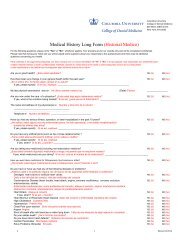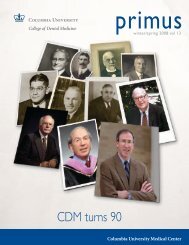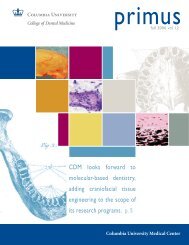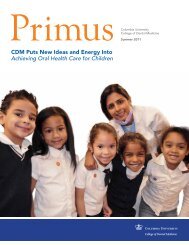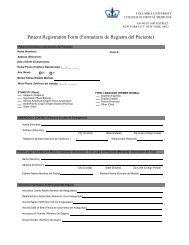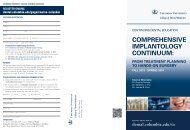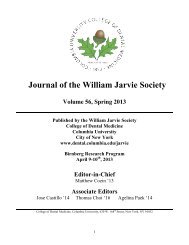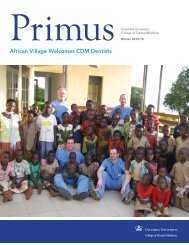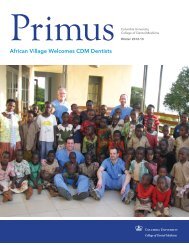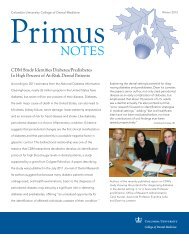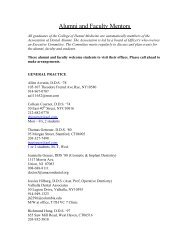Summer 2007 - College of Dental Medicine - Columbia University
Summer 2007 - College of Dental Medicine - Columbia University
Summer 2007 - College of Dental Medicine - Columbia University
You also want an ePaper? Increase the reach of your titles
YUMPU automatically turns print PDFs into web optimized ePapers that Google loves.
from page 1, CBCT<br />
<strong>of</strong> the American Board <strong>of</strong> Oral and<br />
Maxill<strong>of</strong>acial Radiology (AAOMR) and<br />
member <strong>of</strong> the AAOMR executive committee,<br />
Dr. Angelopoulos is responsible<br />
for oversight and development <strong>of</strong> the<br />
<strong>College</strong>'s oral radiology curriculum. He<br />
will also be involved with conceptual<br />
planning and implementation <strong>of</strong> a<br />
school-wide conversion to digital radiography,<br />
and establishing a faculty practice<br />
in oral and maxill<strong>of</strong>acial radiology.<br />
Dr. Angelopoulos has already begun to<br />
present continuing education programs<br />
on CBCT.<br />
Conventional computed tomography<br />
(CT) is used medically to image all areas<br />
<strong>of</strong> the human body. The overlapping<br />
“slices” <strong>of</strong> targeted internal areas,<br />
reassembled as cross-sectional views,<br />
are created by a fan-shaped X-ray beam<br />
rotating around the patient lying on a<br />
slowly advancing table. CBCT, specifically<br />
designed for maxill<strong>of</strong>acial radiography,<br />
uses a cone-shaped beam to take<br />
multiple images during a single, 10-20-<br />
second rotation around the patient's<br />
head. Unlike fan beam tomography, the<br />
narrow CBCT beam can record<br />
mandible and maxilla simultaneously, or<br />
each alone, reducing radiation exposure<br />
and potential patient movement.<br />
Versatile, quick, safe, and easy, CBCT is<br />
accurate to almost two-tenths <strong>of</strong> a millimeter.<br />
Its image quality for hard tissues<br />
like bone and teeth is generally much<br />
higher than medical CT.<br />
CBCT is making strong inroads in guiding<br />
dental diagnosis and treatment. A<br />
2004-2006 survey <strong>of</strong> patient referrals to<br />
an oral and maxill<strong>of</strong>acial radiology group<br />
showed most requests for CBCT scans<br />
came from oral and maxill<strong>of</strong>acial surgeons<br />
(51%) and periodontology specialists<br />
(17%). Other requests were for:<br />
implantology planning (40%), surgical<br />
pathology exploration (24%), and temporomandibular<br />
joint analysis (16%), as<br />
well as planning extractions <strong>of</strong> impacted<br />
teeth and assessing orthodontic needs.<br />
With cone beam's highly accurate measurements<br />
<strong>of</strong> bone and jaw deformities,<br />
bone lesions, and changes <strong>of</strong> the jaw,<br />
dentists can determine a tooth's exact<br />
position relative to neighboring teeth<br />
and structures; discover anatomic abnormalities<br />
in roots, nasal fossa, and sinuses;<br />
and locate pathologies, such as cysts,<br />
tumors, and infections with great precision.<br />
Over half <strong>of</strong> CBCT studies, initiated<br />
for other purposes, uncover incidental<br />
pathologic anomalies, ranging from simple<br />
dental and sinus infections to benign<br />
and malignant tumors and blocked<br />
carotid arteries. CBCT technology promises<br />
to contribute to improved interoperability<br />
between diagnosis and many<br />
types <strong>of</strong> treatments, though not for close<br />
examination <strong>of</strong> caries, because any large<br />
amount <strong>of</strong> metal in the oral cavity will<br />
interfere with imaging decay. The anticipated<br />
evolution <strong>of</strong> CBCT technology<br />
toward even smaller voxel size, however,<br />
may even improve the diagnosis <strong>of</strong><br />
caries.<br />
While CBCT imaging is relatively easy,<br />
its reformatting, display, and interpretation<br />
demand a high level <strong>of</strong> expertise<br />
Christos Angelopoulos DDS, MS<br />
and experience. In the New York area,<br />
dental practices will be able to refer<br />
patients to the CDM's Oral Radiology<br />
Group for cone beam services, receiving<br />
imaging results on their own computer<br />
screens and radiographic interpretations<br />
for each scan made. Area<br />
dentists who use their own CBCT system<br />
may also send scans to CDM for<br />
CT image interpretation.<br />
Dr. Angelopoulos cautions that cone<br />
beam radiography should be used only<br />
when needed. The leadership <strong>of</strong> the<br />
American Academy <strong>of</strong> Oral and<br />
Maxill<strong>of</strong>acial Radiology is currently<br />
developing appropriate selection criteria<br />
for the use <strong>of</strong> cone beam diagnostic<br />
procedures in the pr<strong>of</strong>ession, a topic<br />
included in Dr. Angelopoulos's instruction<br />
to his CDM students. He sums up<br />
his approach to the use <strong>of</strong> dental technology,<br />
saying: “Everything depends<br />
on the wisdom <strong>of</strong> pr<strong>of</strong>essional judgment.<br />
We need to know when to use<br />
what!”<br />
<strong>2007</strong><br />
SUMMER<br />
3



